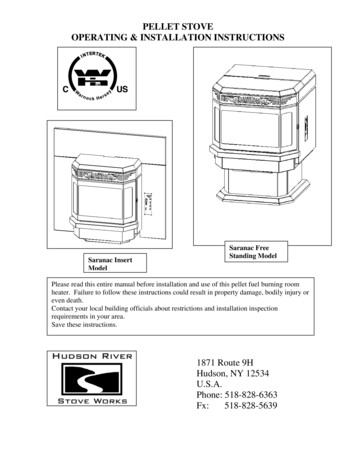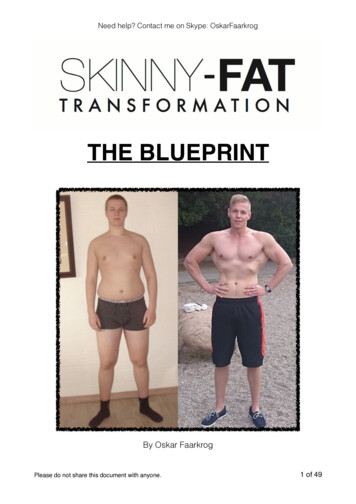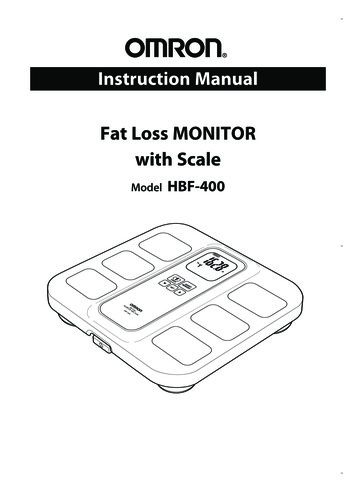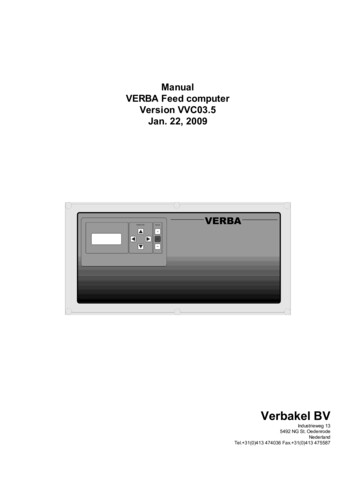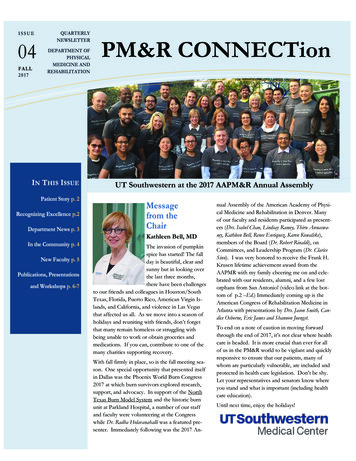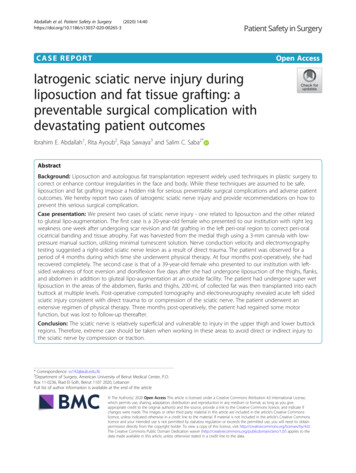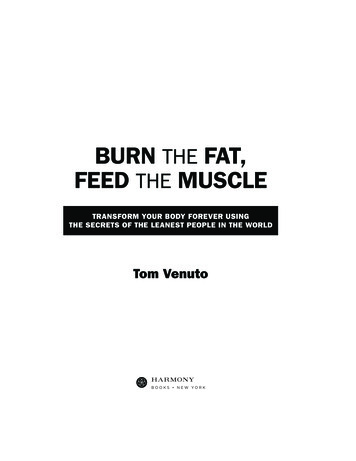
Transcription
BURN THE FAT,FEED THE MUSCLETRANSFORM YOUR BODY FOREVER USINGTHE SECRETS OF THE LEANEST PEOPLE IN THE WORLDTom VenutoVenu 9780804137843 4p all r1.indd 310/17/13 8:50 AM
BURN THE FAT, FEED THE MUSCLETraining (burn more)Dieting (eat less)Raises your metabolic rateSlows down your metabolic rateCreates a caloric deficit without triggering theTriggers the starvation responsestarvation responseProvides countless health benefitsMay be harmful to your healthBuilds and maintains lean body massPromotes loss of lean body massIncreases fat- burning hormonesDecreases fat- burning hormones5. Use the calorie “cycling” method (don’t stay in a deficit too long).You probably know at least one person who always seems to be on a diet. Whilethese “professional dieters” may lose some weight in the beginning, they neverseem to reach their long- term goals. They’re always hitting plateaus and struggling to avoid regaining the weight they lost. God bless them— they never give up!Unfortunately, that’s part of the problem. Each time they plateau or see the scalestart creeping up again, they either panic and cut calories more, or they try all overagain with the latest crash “diet of the month.”When your fat loss slows down or you hit a fat- loss plateau the first time, dropping calories is usually the right decision. But if your calories are already low andyou’ve been dieting for a long time, cutting calories more can dig you into a deepermetabolic rut. It seems counterintuitive, but sometimes the best thing you can doto “reset” a sluggish metabolism is to eat more before going back to the caloricdeficit again.Inserting occasional higher- calorie days between lower- calorie days is a simpletechnique that gives you a nice physical and psychological break from days orweeks of continuous deficit. After months of lower- calorie eating, a full week ortwo of higher- calorie (maintenance level) eating optimizes your hormones andrestokes your metabolic fire.This method of raising your calories periodically instead of staying low all thetime is known as the “cycling” or “zigzagging” method. The bigger your caloricdeficit has been, the longer you’ve been in it, and the lower your body fat becomes,the more important it is to take these diet breaks or “re- feeding” days. This plan26Venu 9780804137843 3p all r1.indd 2610/4/13 11:47 AM
BURN THE FAT, FEED THE MUSCLEYou’re not destined to get fatter as you get older, but in the general (non- athlete)population, the average older person has more body fat. To account for this, I included ranges in my rating scale instead of single numbers. Younger people canuse the low end of the range and older people can use the higher number for setting goals.Body Fat Rating ScaleMaleFemaleCompetition shape (ripped)3% –6%9% –12%Very lean (excellent) 10% 16%Lean (good)10% –14%16% –20%Satisfactory (fair)15% –19%21% –25%Improvement needed (poor)20% –25%26% –30%Major improvement needed (very poor)26% –30%31% –40%Typical Average Body Fat Percentage for AthletesMaleFemaleDistance runners5% –10%10% –16%Elite marathon runners3% –5%9% –12%Sprinters5% –12%12% –18%Jumpers and hurdlers6% –13%12% –20%Olympic gymnasts5% –8%11% –14%Bodybuilders, contest condition3% –5%9% –12%Bodybuilders, off- season6% –12%13% –18%Football players, running backs, receivers, defensive backs7% –9%NAFootball players, linemen16% –19%NASoccer players7% –12%10% –18%Baseball/softball players10% –14%12% –18%Pro basketball players7% –12%10% –16%58Venu 9780804137843 3p all r1.indd 5810/7/13 12:55 PM
THE L.E.A.N. PLAN OF ACTIONTypical Average Body Fat Percentage for Athletes, continuedWrestlers4% –12%NACross- Country skiers7% –13%17% –23%Tennis players10% –16%14% –20%Swimmers6% –12%10% –16%Low numbers are nice for bragging rights, but what counts is whether you’rehealthy and happy with how you look. You can use my charts to help you setsome initial goals, but overall, I recommend using body fat percentage as a wayto track your progress over time. Focus on improving yourself instead of chasingafter some Holy Grail number.HOW LOW SHOULD YOU GO?Competitive bodybuilders and endurance athletes such as marathon runners havebeen known to reach body fat levels as low as 3 percent to 4 percent in men and9 percent to 10 percent in women. With today’s obsession for leanness and theproblem of body image disorders, the safety of dropping to very low body fat levelshas rightfully been questioned. Being extremely lean is healthier than being obese,but trying to maintain extremely low body fat levels for too long might not behealthy or realistic, especially for women.Many women who try to maintain their body fat levels at or below 10 percent to13 percent experience health problems. Their menstrual cycles and reproductivesystems become disrupted and bone density may decrease, putting them at higherrisk of osteoporosis as they grow older.For some athletes, reaching extremes of low body fat during a competitive season is simply part of the sport. Using extreme diets to get there or trying to maintain extreme low body fat is when most of the problems occur. Training and dietingin cycles so body fat levels vary between lean and competition lean is healthier andmore sensible. The typical female figure or fitness competitor maintains a verylean and healthier body fat level 14 percent to 17 percent for most of the year, then59Venu 9780804137843 3p all r1.indd 5910/4/13 11:47 AM
BURN THE FAT, FEED THE MUSCLEwere solid muscle without an ounce of visible fat on your body, and you loved theway you looked in the mirror, would you honestly care how much you weighed?That said, it’s still wise to have a weight goal in pounds as well as a body fat percentage goal. To calculate your ideal body weight, you need to know your currentweight, your body fat percentage, your lean mass, and your target (desired) bodyfat percentage.Enter your lean body mass (LBM)Choose your target body fat % (TBF)Subtract your TBF from 1 (1 – TBF)Divide your LBM by the difference Your ideal weight The ideal weight formula is: lean body mass (LBM) (1 target body fat %). TBF is expressed as a decimal (15% body fat 0.15). You can subtract up to 2%–3% more off the estimated ideal formula weightif you want to account for potential water- weight losses.THE NEXT STEP: TRACKING YOUR PROGRESSYou now have a strong intellectual understanding of body composition and whyit’s so important. When it really sinks in on a practical level is after you start following the nutrition and training plan and start tracking your progress.You’ll learn more about your body by measuring and tracking your bodyweight, body fat, and lean body mass for just a few weeks than you will by readingabout it for years. As the old saying goes, “A single accurate measurement is wortha thousand expert opinions.” Recording your results, getting into a performancefeedback loop, and charting your progress are steps that guarantee you’ll neverfail. You’ll start this process in the next chapter.68Venu 9780804137843 3p all r1.indd 6810/4/13 11:47 AM
THE L.E.A.N. PLAN OF ACTIONThe long- standing traditional advice has been to reduce saturated fat intake.However, without looking at each different type of saturated fatty acid individually and within the context of your genetics, health status, lifestyle, quantity eaten,and overall diet, it’s overly simplistic to say that all saturated fats are bad for you orshould be completely avoided. Saturated fats do, however, lack the essential fattyacids you need, so you must balance them with the unsaturated fats.2. Unsaturated fatUnsaturated fats are subdivided into polyunsaturated and monounsaturated fatsand they come primarily from vegetable and plant sources. They are mostly liquidat room temperature (think olive oil). Generally, they tend to lower levels of bloodcholesterol and have other health benefits or cardio- protective effects. The polyunsaturated fats contain the healthy essential fatty acids (EFAs).SaturatedUnsaturated (Poly)Unsaturated (Mono)Beef fatFish oilOlive oil, olivesPoultry fatFlaxseed oilHigh- oleic sunflower oilOther meat fatsSunflower oilHigh- oleic safflower oilButterfatSafflower oilAvocadoCoconut oil, coconutCanola oilCanola oil (contains both)Cocoa butterSesame oilPeanuts, peanut butterPalm oilPrimrose oilCashewsPalm kernel oilBorage oilPecansShortening, lard, tallowWalnut oil, walnutsAlmonds, almond butterCream, half- and- halfHemp oil, hemp seedsBrazil nutsMilk fatSoybean oilPistachiosCheese fatCorn oilMacadamia nutsCream cheesePine nutsHazelnuts157Venu 9780804137843 3p all r1.indd 15710/4/13 11:47 AM
BURN THE FAT, FEED THE MUSCLEESSENTIAL VERSUS NONESSENTIAL AMINO ACIDSOf the 20 amino acids, your body can make 11. These are called the nonessentialamino acids (also known as dispensable amino acids). The other nine amino acidsare called essential amino acids (or indispensable amino acids). Essential aminoacids are those that can’t be manufactured by your body and must be suppliedfrom your food.Essential (Indispensable) Amino AcidsNonessential (Dispensable) Amino paragineLysineAspartic acidMethionineCysteinePhenylalanineGlutamic lineSerineTyrosine*Leucine, isoleucine, and valine are known as branched chain amino acids, or BCAAs, which are metabolized mostly in muscle and play an important role in protein synthesis. Glutamine is known as aconditionally essential amino acid because under conditions of stress or trauma, you may require moreof it than your body can produce.WHY YOU MUST EAT COMPLETE PROTEINS EVERY DAYFoods that contain all the essential and nonessential amino acids in the exact ratioand amounts required by your body for growth are called complete proteins. Foryour body to synthesize muscle, all the essential amino acids must be availablesimultaneously. Any nonessential amino acids that are in short supply can be pro170Venu 9780804137843 3p all r1.indd 17010/4/13 11:47 AM
BURN THE FAT, FEED THE MUSCLEStarchy Carbs (Grains and Starchy Vegetables)Fibrous Carbs (Nonstarchy Vegetables)PotatoesBroccoliSweet matoesBrown riceCauliflowerLentilsBrussels sproutsChickpeas (garbanzos)CeleryBlack- eyed peasOnions, scallions, leeksGreen peas, other peasBell peppers (red or green), hot peppersCornBok choy, cabbagePumpkinKaleBarleyMushroomsWinter squash (acorn, butternut)EggplantQuinoaZucchini (summer squash)MilletCarrots*Whole wheatString beans, green beans*100% whole grain bread, cereal, or pastaLettuce and all leafy salad greensOther whole grains and starchy vegetablesAll other nonstarchy vegetables, greens,and herbs*Carrots are technically a starchy vegetable, but they’re low in calorie density and high in fiber, sothey’re often included in lists of fibrous carbs. Green beans are also technically starchy carbs (legumes) but also have low calorie density, so they appear on fibrous carb lists as well.190Venu 9780804137843 3p all r1.indd 19010/4/13 11:47 AM
THE L.E.A.N. PLAN OF ACTIONNATIONAL RESEARCH COUNCIL GUIDELINES FOR WATER INTAKECalories ExpendedWater RequiredWater Required2,00067–101 oz.2.0–3.0 liters2,50084–126 oz.2.5–3.75 liters3,000101–152 oz.3.0–4.5 liters3,500118–177 oz.3.5–5.25 liters4,000135–202 oz.4.0–6.0 litersNote: One gallon 128 ounces or 3.8 liters.SHOULD YOU COUNT THE LIQUIDS FROM FOODSAND BEVERAGES TOWARD YOUR WATER INTAKE?These recommendations are based on total water, so all fluids do count. Almost allfoods contain water. Fruits and vegetables are 75 percent to 90 percent water. Evenmeat is at least 50 percent water. Milk, coffee, tea, and sports drinks are mostlywater. Caffeine has a mild diuretic effect, but not enough to cancel the hydrationprovided from caffeinated liquids. (Don’t use caffeinated drinks for rehydration,however.)It’s difficult to determine the exact amount of water you’re getting from food,so don’t bother. In general, the average person gets about 20 percent of their waterintake from food, provided they eat fruits and vegetables every day.It’s not uncommon for bodybuilders to use the total water guidelines as theirdaily target for drinking water. I do. My calorie expenditure is about 3,200 per day,so that’s at least 3.2 liters or usually closer to a gallon (3.8 liters)— well over 8 8. Idrink that amount in pure water every day.My method puts you on the high side when you add water from all sources,but it doesn’t hurt. It offers an extra margin of assurance that your water intakeis more than adequate and perhaps is closer to optimum. Personally, I feel better, train harder, and have more energy when my water intake is on the high siderather than the low side. I’ve heard this sentiment echoed throughout the fitnessindustry for decades.203Venu 9780804137843 3p all r1.indd 20310/4/13 11:47 AM
BURN THE FAT, FEED THE MUSCLEBy the way, this is the same list of foods you’d use for gaining muscle as well. Thedifference is in the amounts. As you learned in Chapter 7 when we talked aboutcalories, to gain muscle, you have to eat in a surplus: same foods, but more of them.THE SIX EXCHANGE GROUPS AND BURN THE FAT,FEED THE MUSCLE FOOD LISTBurn the Fat, Feed the Muscle makes more precise distinctions about food groupsthan most diets. We subdivide carbs into starchy, fibrous, and simple. Proteinsare narrowed down into lean proteins, because we usually don’t want the extra fatcalories (with some exceptions, such as fatty fish). Dairy products are narroweddown to non- or low- fat (to save calories), and fats have their own category. Thatmakes six food groups, and the foods within each group can be exchanged.CARBSStarchy Complex Carbs(Starchy Vegetables andWhole Grains)Fibrous Complex Carbs(Nonstarchy Vegetablesand Leafy Greens)Natural Simple Carbs(Fruit)PotatoesBroccoliApples, applesauceYamsSpinachBananasSweet riesBeansTomatoesStrawberriesBrown riceCauliflowerBlackberriesLentilsBrussels sproutsNectarinesChickpeas (garbanzos)CeleryPlumsBlack- eyed peasOnions, scallions, leeksPeachesGreen peasBell pepper (green or red)PearsCornCabbage, bok choyGrapefruitPumpkinKaleOranges240Venu 9780804137843 3p all r1.indd 24010/4/13 11:47 AM
THE L.E.A.N. PLAN OF ACTIONCarbs, continuedBarleyMushroomsWatermelonWinter squashEggplantPineappleQuinoaZucchini (summer squash)CherriesMilletCarrotsMangoWhole wheatString beans, green beansKiwifruit100% whole grain bread, cereal,Lettuce and leafy salad greensMelon/cantaloupeAll other whole grains andAll other nonstarchy vegetablesAll other whole fruits (dried fruitsstarchy vegetalbesand greensin limited quantities)and pastaLEAN PROTEIN, HEALTHY FATS, AND DAIRYLean ProteinsHealthy FatsDairy (Nonfat or Low- Fat)Chicken breastFish oil (supplement)MilkTurkey breastFlax oil (supplement)CheeseLean beefOlive oil, extra virginCottage cheeseFishNutsYogurtShellfishNut buttersGreek yogurtEggs and egg whitesSeedsLean porkAvocadoBison, venison, and other game meatsCoconutProtein powder (supplements)241Venu 9780804137843 3p all r1.indd 24110/4/13 11:47 AM
BURN THE FAT, FEED THE MUSCLEomelets and scrambles. Spinach and mushroom omelets are a low- carb favorite.Bell peppers, onions, and tomatoes are also great for egg recipes. Potatoes go wellwith eggs when you have room for more starchy carbs. For Mexican eggs, addsalsa (and low- fat cheese if you have room for the calories). For a Greek omelet, tryspinach, feta cheese, and olives.Yogurt or cottage cheese and fruit is a popular light, quick breakfast or mid- morning snack. Protein smoothies with fruit are also great in the morning or anytime you’re in a hurry. Rolled oats can also be added as a whole food ingredientin a protein drink; that’s been a hotel room breakfast for me many times (cheaperthan the restaurant too).Here’s a week of sample breakfasts:Breakfast 1Lean ProteinStarchy CarbFibrous Carb (or Fruit)Scrambled eggsFour‑grain hot cereal withBlueberriesflaxBreakfast 2Vanilla whey proteinOld- fashioned oatmeal with Applesauce or choppedcinnamonapplesBreakfast 3Hard- boiled eggsEzekiel breadMixed fruit bowlBreakfast 4Egg omelet (with veggies)Steel cut oats (withSpinach and mushroomschopped walnuts)Breakfast 5Egg scramblePotatoBell peppers, onions, salsaBreakfast 6Nonfat milkShredded wheatGrapefruitBreakfast 7Greek yogurtNone (light meal or snack)Banana244Venu 9780804137843 3p all r1.indd 24410/4/13 11:47 AM
THE L.E.A.N. PLAN OF ACTIONBurn the Fat, Feed the Muscle Meal Ideas: Lunch and DinnerAs with all meals, for lunch or dinner, you begin by choosing a lean protein such aschicken breast, lean beef, or fish. Second, you choose a starchy carb such as brownrice, yam, or potato. Third, choose a fibrous carb such as broccoli or salad.Here’s a week of sample lunch or dinner meals:Lean ProteinStarchy CarbFibrous Carb (or Fruit)Lunch/Dinner 1Chicken breastBrown riceBroccoliLunch/Dinner 2SalmonYamAsparagusLunch/Dinner 3Lean beef, top roundBaked potatoGreen and veggie saladwith olive oil balsamicdressingLunch/Dinner 4Tilapia fishLentilsMixed vegetablesLunch/Dinner 5Lean ground turkeyRice and beansSalsaLunch/Dinner 6Extra-lean ground beefWhole grain pastaTomato sauce, saladLunch/Dinner 7Sliced turkey breastWhole wheat breadLettuce and tomato, appleBurn the Fat, Feed the Muscle Template for Creating Daily Meal PlansYou can use a template for daily meal plans just as you did for individual meals.Using templates makes everything “plug- and- play” easy and allows unlimited variety. All you have to do is choose the foods and plug them into the slots. Thebaseline nutrition template is where most people start. The accelerated fat- loss(“competition diet”) templates, which have fewer starchy carbs and more protein,are the next level; we’ll cover that in the final chapter.THE BURN THE FAT, FEED THE MUSCLE DAILY MEAL PLAN TEMPLATEFirst, let’s take a look at a blank template:245Venu 9780804137843 3p all r1.indd 24510/4/13 11:47 AM
BURN THE FAT, FEED THE MUSCLEMeal 1Time:Lean proteinStarchy carbFibrous carbMeal 2Time:Lean proteinStarchy carbFibrous carbMeal 3Time:Lean proteinStarchy carbFibrous carbMeal 4Time:Lean proteinStarchy carbFibrous carbMeal 5Time:Lean proteinStarchy carbFibrous carbHere’s an example of a Burn the Fat, Feed the Muscle daily meal plan for men,based on the previous template:Meal 1Time: 6:00 a.m.Scrambled eggs/omelet (2 whole, 3 whites)Whole wheat toastSpinachMushroomsOrange51 slice1 cup½ cup1 mediumMeal 2Time: 9:00 a.m.Vanilla whey proteinOld- fashioned rolled oatmealBanana1½ scoops¾ cup1 largeMeal 3Time: 12:30 p.m.Chicken breastBaked potatoGreen salad with cucumber and tomatoOlive oil and balsamic dressing6 oz.8 oz.3 cups2 tbsp.Meal 4Time: 3:30 p.m.SalmonYamAsparagus5 oz.6 oz.6 oz.Meal 5Time: 7:30 p.m.Lean beef, top roundBrown riceBroccoli6 oz.1 cup1½ cupsTotal: 2,344 calories; 195 grams protein, 278 grams carbs, 47 grams fat246Venu 9780804137843 4p all r1.indd 24610/17/13 8:50 AM
THE L.E.A.N. PLAN OF ACTIONHere’s an example of a Burn the Fat, Feed the Muscle daily meal plan for women,based on the previous template:Meal 1Time: 6:00 a.m.Scrambled eggs/omelet (1 whole, 3 whites)Light whole wheat toastSpinachMushrooms41 slice1 cup1 cupMeal 2Time: 9:00 a.m.Greek yogurt, vanillaBanana6 oz.1 mediumMeal 3Time: 12:30 p.m.Chicken breastBaked potatoGreen salad with cucumber and tomatoOlive oil and balsamic dressing4632Meal 4Time: 3:30 p.m.SalmonYamAsparagus5 oz.5 oz.3 oz.Meal 5Time: 7:30 p.m.Lean beef, top roundBrown riceBroccoli4 oz.¾ cup1 cupoz.oz.cupstbsp.Total: 1,690 calories; 144 grams protein, 195 grams carbs, 34 grams fatAn alternate schedule with a later morning start might be: meal 1— 8:00 a.m.; meal 2— 12:00 p.m.;meal 3— 3:30 p.m.; meal 4— 6:30 p.m.; meal 5— 9:30 p.m.Women who are short and small framed, who don’t have a large calorie budget, might opt for the four- meal plan or the three- meals- with- snacks plan.To make sure your calorie and macro numbers are on target, add up your mealsubtotals and your daily meal plan totals. Then increase or decrease the servingsizes so you’re close to your calorie and macronutrient goals. If you want themost precision, use a spreadsheet, app, or nutrition software. You can downloada free interactive meal planner Excel sheet at www .Burn The Fat Feed The Muscle .com.Some people find making daily meal plans challenging at first, but usually onlybecause they’re trying too hard to micromanage their macronutrients. Remember,macronutrient ratios don’t have to be perfect. If you stick close to this template, themacros will fall right into the ballpark. After your initial setup, you’ll simply needto adjust the serving sizes to get close to your calorie target.247Venu 9780804137843 3p all r1.indd 24710/4/13 11:47 AM
THE L.E.A.N. PLAN OF ACTIONyou’ll save a lot of calories by getting away from butter and oil in general. On fat- loss programs, most people don’t have the extra calories to spend. Instead, a lightcoat of nonstick cooking spray does the trick.Sample Breakfast RecipesMeal TemplatePortable Apple- Healthy Greek Cinnamon High- Omelet Protein OatmealPancakeLazy Person’sMexican EggsPumpkin SpiceOatmealLean Protein1 whole egg3 egg whites1 whole egg1 whole egg1 scoop vanilla3 egg whites5 egg whites1 scoop vanillawhey protein¼ cup feta cheese¼ cup low-fatshredded cheesewhey proteinStarchy CarbFibrous Carb¾ cup rolled oats½ apple, finely2/3cup oatmeal1 cup spinach¼ cup salsa½ can pumpkin8 olives, pittedChili powderCinnamon,choppedExtra(Spices, etc.)Cinnamonnutmeg,sweetener253Venu 9780804137843 4p all r1.indd 25310/17/13 8:50 AM
BURN THE FAT, FEED THE MUSCLELunch and Dinner RecipesMeal TemplateMuscle- MakingTeriyakiChicken Stir- frySimple SalmonSalad SandwichTom’s BakedTilapiaBeefy SpanishRiceLean Protein5‑oz. chicken6‑oz. can salmonTilapia12 oz. lean groundbreastStarchy Carbbeef¾ cup brown rice2 100% whole- Sweet potato grain pitas2 cups long- g rain brown rice(cooked)Fibrous CarbBroccoli15‑oz. can diced½ cup each¼ cup finelychopped carrots,chopped celerytomatoesgreen pepper,½ cup finely2 tbsp. tomatomushrooms,chopped onionpaste1 green bellonionspepper1 large yellowonionExtraLow- calorie2 tbsp. lemonSeason tilapiaWorchestershire(Spices, etc.)teriyaki saucejuicewith olive oil,sauce, thyme,1 tsp. groundlemon juice,garlic powder,black pepperpaprika, parsley,black pepperoregano, pinch ofsalt(serves 1)(serves 2)(serves 1)(serves 3)WHY YOU SHOULD “CHEAT” AND MAKEFREE MEALS A PART OF YOUR PLANTo an athlete, food is fuel, food is building material, and at times great nutritionaldiscipline is required to achieve big goals. But food is also one of life’s great pleasures and an important part of our social lives. When you deprive yourself completely, it can make you more likely to binge, crave missed foods, and give up. It’ssimply human nature to want what you can’t have. That’s why, for most people, it’sbetter to allow cheat meals. But there’s a right and wrong way to do it.254Venu 9780804137843 4p all r1.indd 25410/17/13 8:50 AM
BURN THE FAT, FEED THE MUSCLEworkout? With six workouts at 600 calories per workout, you’d be up to 3,600 calories per week. You just tripled your fat loss!Could speeding up fat loss really be that simple? Well, your body is deviouslycomplex in the ways it can adapt or trigger compensation, and there’s a pointwhere doing more brings diminishing returns or gets impractical. But if all elseremains equal, then yes: The more often you do cardio, the more calories you’llburn and the more fat you’ll lose. You don’t even need to know how many caloriesevery workout burns; just realize that there’s a direct dose- response relationship.When you multiply frequency with duration and intensity, you can accelerate yourfat loss exponentially.Let me put it this way: If I were overweight and I knew what I know now aboutfat loss, I would be doing cardio every day, possibly even twice a day, seven days aweek, until I was happy with my weight. Only then would I taper down to a maintenance program.That said, it’s usually better to build up gradually. Many beginners try to do toomuch too soon, then they find themselves burned out or injured, especially if thecardio was intense or high- impact. Start with at least three sessions per week, andif your goal is maximum fat loss, progressively build up to five, six, or seven daysper week as your weekly results dictate.BURN THE FAT, FEED THE MUSCLE FREQUENCY GUIDELINESFOR CARDIO TRAININGFor maintenance, health, and fitnessFor maximum fat loss3–4 days per week5–7 days per weekDURATION OF CARDIO TRAINING: HOW LONG?If your cardio is high in intensity, the sessions will be shorter and you’ll still burna lot of calories. If your cardio is low- intensity, you need to exercise longer for thecalorie burn to accumulate. If your goal is fat loss, 30 to 45 minutes at a moderateintensity is usually more than enough time to achieve the type of calorie burn you268Venu 9780804137843 3p all r1.indd 26810/4/13 11:47 AM
BURN THE FAT, FEED THE MUSCLEBURN THE FAT, FEED THE MUSCLE DURATION GUIDELINESFOR CARDIO TRAININGFor maintenance, health, and fitnessFor maximum fat loss20–30 minutes per session (moderate to intense)30–60 minutes per session (moderate)20–30 minutes per session (intense)INTENSITY OF CARDIO TRAINING: HOW HARD?You can always burn more calories by working harder in the time you have, butthere is a catch. If you sprint, you burn an enormous amount of calories per minute, but you won’t last long. If you pace yourself leisurely, you could keep goingfor hours, but you won’t burn many calories per minute. If you want maximumfat loss, the trick is to work hard enough so you hit that sweet spot for maximumcalorie burn.One way to find your ideal training intensity is by heart rate. The “age- predicted”method has been recommended in fitness books for decades. You estimate yourmaximum heart rate (MHR) with this formula: 220 minus your age. Then multiply your MHR by a target intensity range of 70 percent to 85 percent. Choose70 percent to 75 percent for moderate; 75 percent to 80 percent for moderatelyhard; or 80 percent to 85 percent for hard.Here’s an example: If you’re 30 years old, your estimated MHR is 190. For amoderately intense workout, multiply the 70 percent to 75 percent intensity rangeby 190 and you get a target heart rate zone of 133 to 142 beats per minute (bpm).During each cardio session, periodically check your pulse at your wrist or neck.The easy way is with 10- second counts: Simply divide your 60- second target heartrate by 6. If your target zone is 133 to 143 bpm, your 10- second count is 22 to 24.If you’re below your target zone, raise the intensity by increasing resistance, speed,or incline. Many people invest in a heart rate monitor. A chest strap transmitsyour heart rate to a wristwatch or cardio machine, letting you check your heartrate easily without interrupting your training rhythm.The classic 220- minus- age formula can underestimate MHR in older adults andoverestimate it in young people by as much as /‒10 bpm. A new equation (the270Venu 9780804137843 3p all r1.indd 27010/4/13 11:47 AM
THE L.E.A.N. PLAN OF ACTIONSeals formula) was published in the Journal of the American College of Cardiology:208 – 0.7 age. This decreases the margin for error at the age extremes. If youreally wanted to know your actual MHR, you’d need to do a maximal exercise test,in which an exercise physiologist hooks you up to a bunch of monitors and runsyou faster and steeper until you cry uncle.All heart rate formulas are only estimates, so use common sense about howyour exertion level feels. If it feels ridiculously easy, then don’t be afraid to increasethe intensity. If it feels incredibly difficult, don’t hesitate to decrease the intensity.BURN THE FAT, FEED THE MUSCLE INTENSITY GUIDELINESFOR CARDIO TRAININGModerateModerately hardHardVery hard (sprints)70% –75% of MHR75% –80% of MHR80% –85% of MHR85% of MHRHOW TO ESTIMATE TRAINING INTENSITYWITH PERCEIVED EXERTIONThe rating of perceived exertion (RPE) is a simple shortcut method for estimatingthe intensity of your workout. You simply rate how hard your workout feels on ascale from 1 to 10. Even though it appears simplistic and is completely subjective,perceived exertion is surprisingly reliable. Basically, if you think your workout is“very hard,” like an 8 out of 10, it probably is.Based on the 1 to 10 RPE scale, a 4 to 8 would be the ideal target zone for steadystate cardio and also for hitting that fat- burning sweet spot— not too easy, nottoo hard.271Venu 9780804137843 3p all r1.indd 27110/4/13 11:47 AM
BURN THE FAT, FEED THE MUSCLERATING OF PERCEIVED EXERTION (RPE)0nothing (no work: sitting or lying)1very, very light2very light3light4moderate5somewhat hard6moderately hard7hard8very hard9very, very hard10maximal (all- out)Breathing and Sweating as Measures of Exercise IntensityBreathing rate is another way to estimate training intensity. If you’re not breathingheavily, you’re not working hard. If you’re so out of breath that you can’t finish asentence or hold a conversation (the “talk test”), your intensity is probably too highfor steady- state training.Sweating, on the other hand, is not a good gauge for training intensity or calories burned. Sweat is simply your body’s cooling mechanism, which gets turned onwhen your body temperature rises. Heavy sweating will lead to weight loss but notfat loss. Water weight comes right back as soon as you rehydrate.HIGH- INTENSITY INTERVAL TRAINING (HIIT)FOR TIME- EFFICIENT FITNESS AND FAT LOSSIf you want to burn the most calories possible during a workout, the way to doit would be through high intensity and long duration. The problem is that intensity and duration are inversely related; or, as they say, you can’t sprint through a272Venu 9780804137843 3p all r1.indd 27210/4/13 11:47 AM
THE
BURN THE FAT, FEED THE MUSCLE 26 5. Use the calorie “cycling” method (don’t stay in a deficit too long). You probably know at least one person who always seems to be on a diet. While these “professional dieters” may lose some weight in the beginning, they never seem to reach their long-term goals. They’re always hitting plateaus and .


